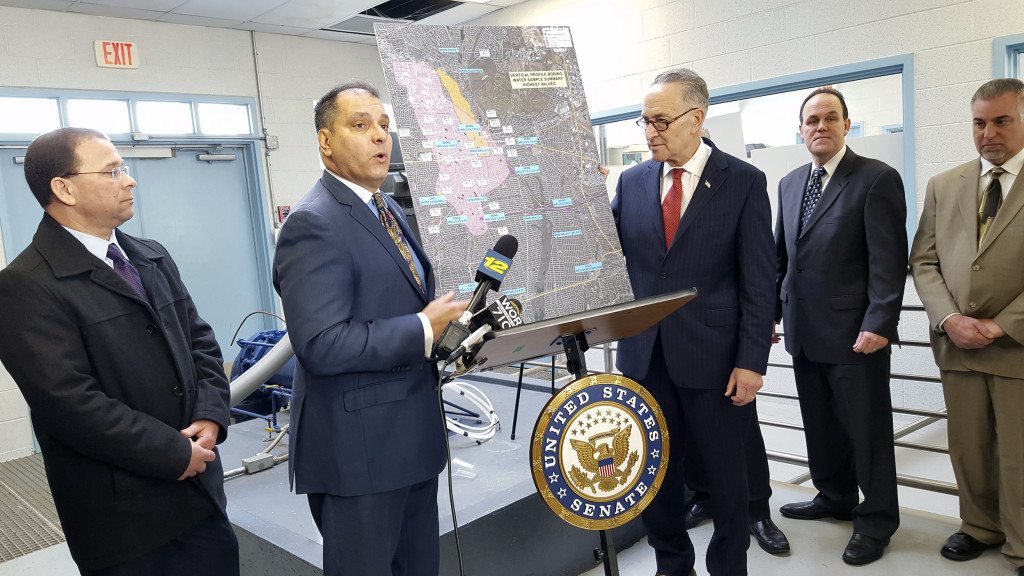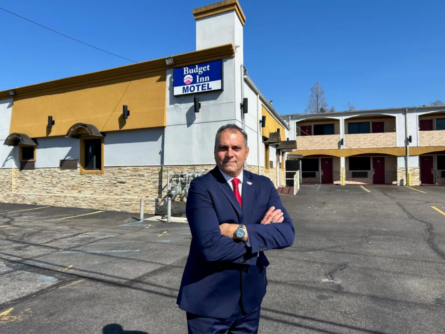
Last week, U.S. Senator Chuck Schumer called on the U.S. Navy and Northrop Grumman to immediately share data from their monitoring wells with all affected Long Island water districts. Schumer is urging the Navy and Northrop Grumman to work closely with these water districts in order to define the reach of the plume and to remediate it.
“The U.S. Navy and Northrop Grumman must stop stonewalling and start sharing when it comes to information about potentially carcinogenic chemicals like Trichloroethylene (TCE) that show up in nearby monitoring wells and potentially threaten Long Islanders’ precious drinking water supply. They must be more forthcoming when it comes to information needed to help remediate the Bethpage plume and they need to be more proactive in cleaning up the mess they made” he said. “Once again, the Navy and Northrop Grumman have made things even more difficult for the Long Island water districts and ratepayers. Every day they fail to promptly share critical information is another day when this plume could creep closer to drinking water supplies. These impacted communities need and deserve timely information about the extent and content of the plume, and they need the Navy and Northrup Grumman to do more to remediate this toxic threat.”
Several months ago, Assemblyman Joseph Saladino, who has consistently championed this issue and passed legislation forcing the NYS DEC to prepare the data needed to effectively contain and clean up these dangerous chemicals, spoke of the purification process, stating that it was very similar to that of the role of a fish tank filter.
“The cycling of the water over and over would take the contaminants out, just like a fish tank filter,” he said. “In order to do this, we need to bring everyone together, all of the elected officials and water districts, and find the best way to go about it.”
According to Saladino, the best option is to utilize a combination of hydraulic containment and well head treatment.
“We have been proving all along that this is the right thing to do to protect our water and the Great South Bay and to stop the plume from moving,” said Saladino. “It’s the best way the experts—all water districts, engineers, environmental engineers—have come up with and I want to make sure that we use all data and resources and that we get money from the federal government, namely the Navy and Grumman, because both are responsible parties. We need to do this right and not cut corners to save money.”
In November, the Massapequa Water District requested access to the wells in order to perform an isotope analysis on water from the Superfund site in Bethpage. The water district wanted to test whether the contaminated water had the same chemical composition as the water in the monitoring wells. As of December, the Navy and Northrop Grumman were still reviewing the water district’s request. Schumer said that the Massapequa Water District should be allowed to access this data, especially because the plume is slowly making its way towards Massapequa.
At the press conference, Saladino spoke of the delays in the process.
“It is obvious that the foot-dragging is an attempt by the responsible parties to stall the cleanup process and avoid the financial responsibility of removing the plume,” he said, noting that each day the plume moves, it increases in size and contaminates clean portions of the water supply. “During WWII and through the Vietnam War, Long Islanders were there for our American government and the protection of our country’s freedom. It’s about time that the Navy, Grumman and our nation are here for us. Clean water is too precious for this stalling. Turn over the data, clean up the plume once and for all, and do it now.”
Massapequa Water Commissioner Raymond Averna, who was recently elected as the Nassau Suffolk Water Commissioners’ Association (NSWCA) president, also spoke of the seeming lack of urgency in remedying the problem.
“In the Navy and Grumman response letters to Massapequa Water District’s CSIA sampling request, they continue to deflect responsibility and place an added financial burden on the water suppliers and taxpayers,” he said.
There are at least two plumes within the Bethpage community caused by the U.S. Navy’s decades-long operation of a Naval Weapons Production Facility. While there have been efforts to mitigate the effects of the plume, these efforts have continued to fall short. Specifically, elevated levels of a potential carcinogen, TCE, an industrial solvent used at the former defense plant, was found in the area. Just recently, the Massapequa Water District requested data from the monitoring wells in an effort to protect the drinking water for the community they serve. However, it has taken months for the Navy to review this request.
Schumer said that all affected water districts should be granted access to data from these monitoring wells to help manage and prevent the spread of the plume. Since 1976, when contamination concerns were first identified, the plume has spread and is currently threatening more than 20 additional public drinking wells that serve more than 250,000 Nassau County residents in Bethpage, Levittown, Massapequa, South Farmingdale and Wantagh.
There are at least two plumes currently within the Bethpage community, and contaminants were detected in five of the eight wells operated by Bethpage Water District. The first plume originated from the Grumman Aerospace Corporation and Navy manufacturing facilities, and the smaller plume is associated with the Bethpage Community Park where Grumman and the Navy disposed of wastes.































